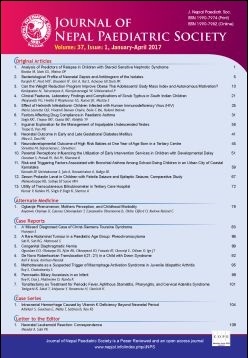Status Disclosure in HIV infected children in Abakaliki, Ebonyi state, Southeast Nigeria
DOI:
https://doi.org/10.3126/jnps.v37i1.18721Keywords:
Adherence, ART, HIV infection, Status disclosureAbstract
Abstract:
The emotional and psychosocial issues surrounding HIV infection make status disclosure herculean task.1Many caregivers are unwilling to disclose because they are afraid of possible unpleasant outcome. This study was done to determine the prevalence rate of HIV status disclosure and possible effect on ART adherence. It was a cross sectional study that involved consecutive recruitment of 94 confirmed HIV infected children aged 5-17 years. Structured questionnaire was used to obtain information on socio-demographic, disclosure and adherence. Assessment of adherence was done in the clinic by direct questioning and pill count. A total of 31 (33.0%) have received a form of information regarding their HIV status. The mean age of disclosure was 12.48± 2.46 years. Majority (95.5%) of the children that received full information about their HIV status were adolescents. Circumstantial disclosure was seen in 25 (81.0%) out of the 31 subjects. A total of 61.3% of HIV status disclosure was done in hospital setting by health workers and 81.8% of subjects that were given full information about HIV were from health workers in a hospital setting. There was however no relationship between adherence to ART and status disclosure (p= 0.832)
In conclusion, the age at which HIV status was disclosed to subject was rather late in this study and majority of the disclosure were consequent to prevailing circumstances in the subjects’ life. A step-wise approach to disclosure that entailed giving age dependent information as from the age of 7 years, with the aim of full disclosure at 10 years is therefore recommended
Downloads
Published
How to Cite
Issue
Section
License
Authors who publish with this journal agree to the following terms:
Authors retain copyright and grant the journal right of first publication with the work simultaneously licensed under a Creative Commons Attribution License that allows others to share the work with an acknowledgement of the work's authorship and initial publication in this journal.
Authors are able to enter into separate, additional contractual arrangements for the non-exclusive distribution of the journal's published version of the work (e.g., post it to an institutional repository or publish it in a book), with an acknowledgement of its initial publication in this journal.
Authors are permitted and encouraged to post their work online (e.g., in institutional repositories or on their website) prior to and during the submission process, as it can lead to productive exchanges, as well as earlier and greater citation of published work (See The Effect of Open Access).



